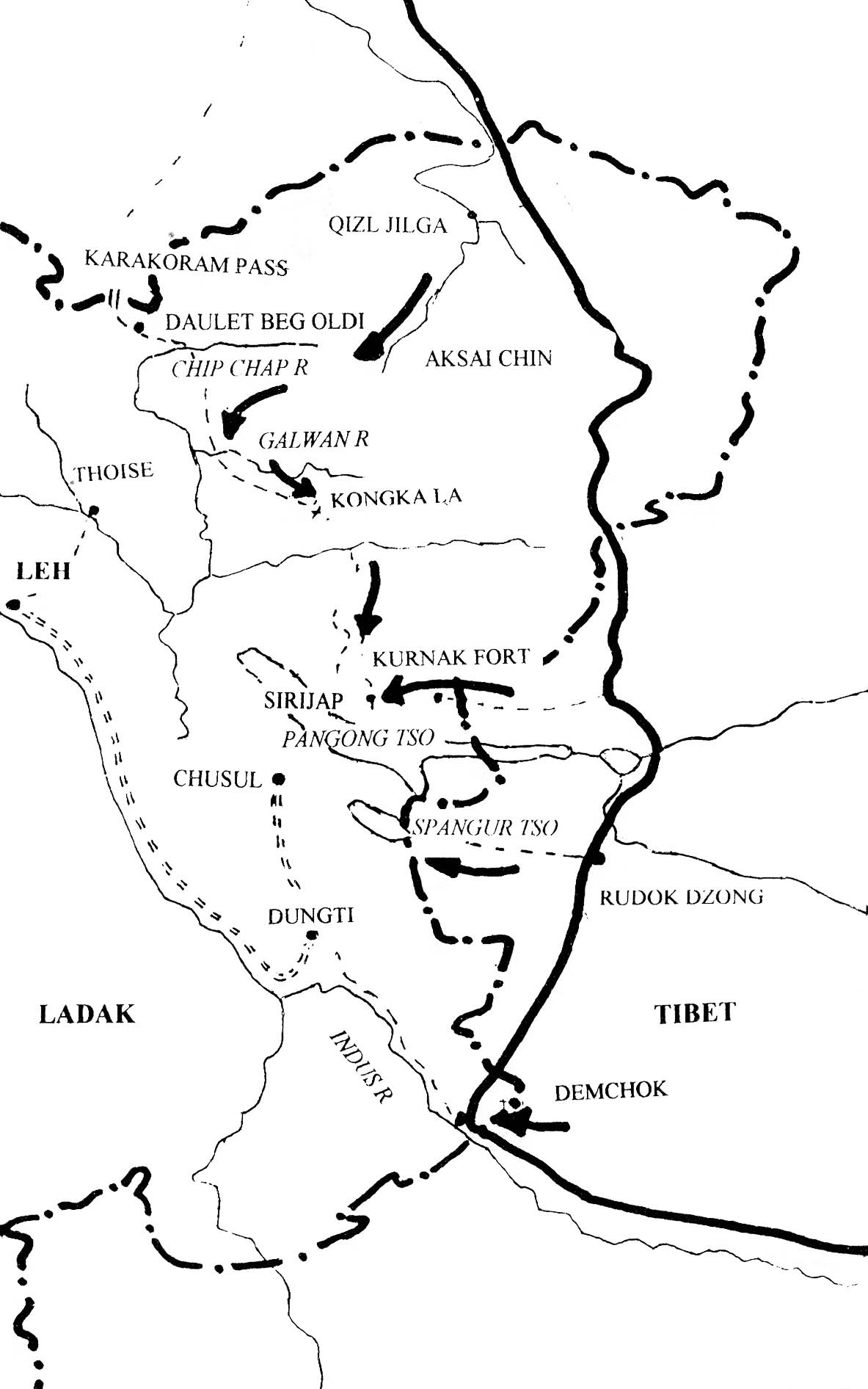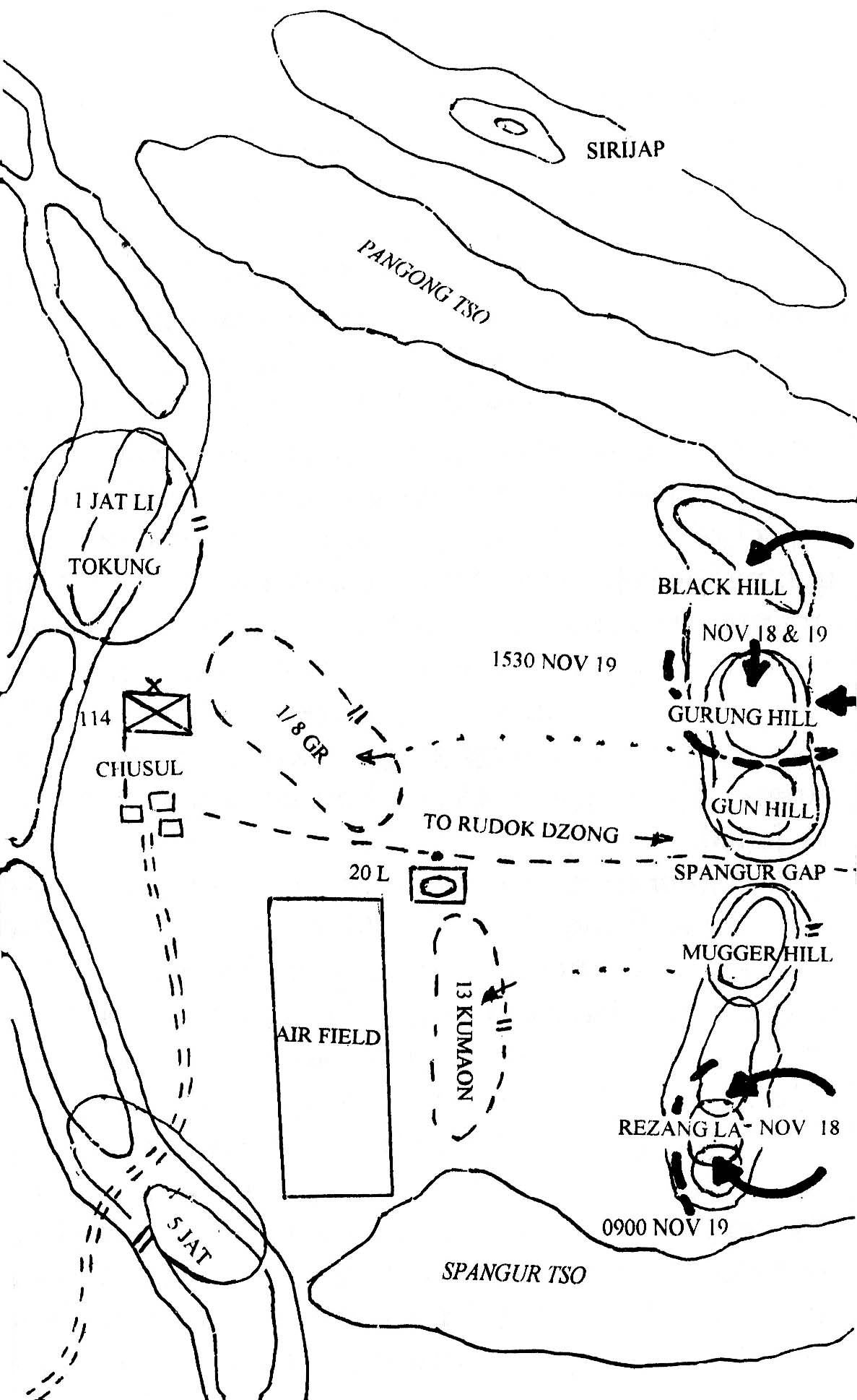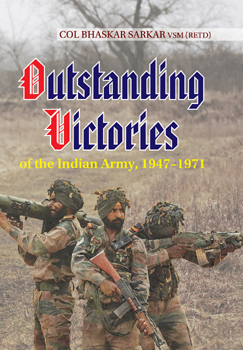Background to the Battle
The war with China in 1962 is remembered as a national debacle and a litany of disasters. Under Pandit Nehru as Prime Minister, the Indian Armed forces were totally neglected from 1949 to 1962. There was no modernisation. There were acute shortages of every kind of arms, ammunition and equipment. Sycophants ruled the roost in the higher echelons of the armed forces and the Defence Ministry. So when it was discovered that the Chinese had intruded into large tracts of Indian Territory in Ladakh and NEFA (now Arunachal Pradesh) and the Army was called upon to evict the enemy and restore territorial integrity of the country, it failed miserably. The officers and jawans fought gallantly and died. But they did not win battles. They were simply overrun by an enemy superior in both equipment and numbers. Within weeks, the Chinese had almost reached the plains of Assam. India did not have troops to defend Assam and the North East. Pandit Nehru even bid them an emotional good bye. Then, suddenly, without any apparent reason, the Chinese went back. Assam and the North East were saved by default. The Chinese War of 1962 produced many martyrs but only one victory. It was the Battle of Chusul in Ladakh.
By 1962, China had usurped 38,000 square kilometres of Indian Territory in Ladakh and built the Lhasa – Sinkiang Road. They had a force equivalent of about four brigades in Aksai Chin, the area occupied by them in Ladakh. They had developed a number of roads and tracks to their border posts. They had also developed a number of garrisons and supply depots. Till the end of September 1962, India had only one weak brigade in Ladakh, the 114 Brigade. The pleas of Western Command to locate an infantry division with four brigades in the area to have a parity of forces in the region had been turned down by the Government. 114 Brigade had only two regular battalions, 1/8 GORKHA RIFLES and 5 JAT and the Jammu and Kashmir Militia. The troops were strung out in small posts and pickets from Daulet Beg Oldi near the Karakoram Pass in the north to Demchok in the south, a distance of about 200 kilometres (See Map). Most of these posts were there only to show possession of territory. Without any artillery support, they had very little fighting potential. In case of hostilities, all they could do was to act as early warning elements. Brigadier TN Raina (later Chief of Army Staff) took over the command of 114 Brigade in 1962.
The Indian Government did not think that the Chinese would retaliate to the Indian efforts to evict them from NEFA. Hence no effort was made to adequately reinforce this sector. The only reinforcement sent was 13 KUMAON together with one platoon of 1 MAHAR, machine guns. Even at this stage,. India had no idea of the Chinese design. 13 KUMAON remained in Leh and were warned that they might have to move to Chusul in March 1963.
The Chinese attacks started in the early hours of October 20, 1963. The Indian troops on the high altitude posts had already started thinning out for the winter. The attacks came on a wide front. In the north, the post at Chip Chap River, held by Jammu & Kashmir Militia was attacked. The troops fought valiantly but were overwhelmed by a numerically superior enemy. They were ordered to withdraw to east of Daulat Beg Old!. Two days later, the Chinese threatened to encircle Daulat Beg Old!. The troops were told to withdraw and fell back to Thoise, north of Leh.
India had two posts at Sirijap on the northern shores of Pangong Lake. They formed the first line of defence of Chusul from the north and were thus of vital importance. It was held by one company of 1/ 8 GORKHA RIFLES under Major Dhan Singh Thapa. The company came under fierce attack from the Chinese on October 21. The attack was launched after heavy shelling. The GORKHAs beat back the first attack. Though the enemy suffered heavy casualties, it brought in reinforcements and attacked after more shelling. The GORKHAs beat back this attack as well. The company had suffered heavy casualties and their strength was depleted. But they were determined to fight to the last. The Chinese attacked again. The company was finally overrun. Major Thapa got out of his trench and killed many of the enemy before he ran out of ammunition and was taken prisoner. For his gallantly, he was awarded the Param Vir Chakra. Only seven men of the company returned from the battlefield alive.
The Chinese continued their victorious advance. Kongka La, Ghalwan, Hot Springs and Demchok fell 66 Outstanding Victories to the enemy. Mer the fall of Sirijap, it was decided to withdraw all troops north of Pangong Lake. This was carried out with the help of two storm boats manned by 36 Field Company, Engineers. At this stage it was appreciated that Chusul would be the next Chinese objective.
Chusul was an important village in South Ladakh. It lay on the old route to Rudok Dzong, which was now an important Chinese garrison. The Indian Army Engineers had built an all weather airfield here for maintaining its troops in the region. They had also built a 293 kilometre track connecting Chusul to Leh via Dungti. Thus, it was an important logistic base for the area. The Chusul Valley is a narrow sandy tract at an altitude of 4337 metres. At its northern end is the beautiful Pangong Tso (lake). On its east and west, lofty mountains that rise up to 5,790 metres flank the valley. There is a parting in the mountains to the east called the Spanggur Gap. Through this gap runs the road to Rudok Dzong which skirts another beautiful lake called the Spanggur Tso. The Chusul airfield was at the southern end of the Valley not far from the Spanggur Gap. The Chinese had built a track right up to the mouth of the gap as a part of their preparation for battle. The area was held by 1/8 GORKHA RIFLES.
The Corps Commander, Lt General Daulet Singh visited Chusul on October 9 to assess the defence potential of the area. Reinforcements started arriving at Chusul after a few days. By October 13, 13 KUMAON was deployed at Chusul. 9 DOGRA began to arrive at Leh and was deployed on the Leh – Chusul road. By the end of October, 3 Himalayan Division was raised under Maj General Budh Singh at Leh for co-ordinating the defence of the region. The three brigades of the division and their deployment was as under:–
-
- 70 Mountain Brigade was deployed at Dungti for the defence of southern Ladakh.
- 114 Mountain Brigade under a Brigadier was concentrated at Chusul and made responsible for its defence.
- 163 Mountain Brigade began to arrive at Leh on November 10 and took over the responsibility for northern Ladakh.
Further reinforcements began to arrive at Chusul towards the end of October. These included a troop of 20 Lancers (AMX Light Tanks), 38 Field Battery of 13 Field Regiment, a troop from 38 Heavy Mortar Regiment, 1 JAT LIGHT INFANTRY and Y Company 1 MAHAR machine guns. The Indian Air Force played a major part in the build up at Chusul. Before the Chinese invasion, Chusul received hardly one aircraft per day. Now the Air Force flew in sortie after sortie bringing in troops, tanks, guns and other equipment. It now had to daily cope with six AN12 and eight C- 119 transport aircraft. 9 Field Company responsible for maintaining the airfield had to be reinforced to enable it to cope with the task.
Relative Strength
The exact strength of the Chinese Forces is not available. But the Chinese are estimated to have concentrated over one infantry division with additional artillery. Their lorries came right up to their post at Spanggur Gap. They appeared to pay maximum attention to this area.
-
- The orbat of 114 Mountain Brigade was as under:–
- 1/8 GORKHA RIFLES
- 13 KUMAON
- 1 JAT
- LIGHT INFANTRY
- 5 JAT REGIMENT
- Troops from 20 Lancers (AMX Light Tanks)
- 38 Field Battery
- Troops from 38 Heavy Mortar Regiment
- ‘Y’ Company 1 MAHAR machine guns
The Brigade held a frontage of about 40 kilometres. But the main defences were concentrated for the protection of the Spanggur Gap (Refer Map). Gurung Hill (4890 m), Gun Hill north of the Gap and the Gap itself were held by 1/8 GORKHA RIFLES. Two companies of 13 KUMAON held Mugger Hill (5182 m) south of the Gap. Further south was Rezang La (5005 m), a pass through which a track from Tibet passed south and east of Spanggur Tso. One company of 13 KUMAON held this pass. The northern approaches to Chusul were guarded by 1 JAT LIGHT INFANTRY with other attached troops and were deployed in Tokung area. 5 JAT protected the southern approach and were deployed as Tsaka La on the Leh Chusul Road. The airfield was the Brigade’s vital ground. The defences were well prepared with bunkers with overhead protection. All infantry positions had barbed wire obstacles and mines. Six second lines of ammunition in addition to one first line, food and water was stocked in the defences. As per the Brigade War Dairy records “Our troops are well dug down, arms tested, their ammunition next to them and their hearts well set to face the Yellow Devil”.
The Battle
The battle commenced on Sunday, November 18, 1962. It was a bitterly cold misty morning. The visibility was only about 350 metres. The Chinese began with a silent attack on Rezang La in the early hours of the morning. They had concentrated the troops during the night to surprise the Indians. C Company of 13 KUMAON held Rezang La. The Battalion headquarters was 10 kilometres away. The Company was without artillery support due to its distance from the main defences. At about 0400 hours a patrol of 13 KUMAON spotted the Chinese soldiers climbing the hillside and raised alarm. Within minutes every man in the company led by Major Shaitan Singh were in their firing positions. The light machine guns and mortars now rained down upon the enemy. The slopes of the pass were full of dead and wounded Chinese. The surprise attack had been detected and had failed.
The Chinese now started massive shelling of the whole front from Gurung Hill to Rezang La. The shelling was particularly intense at Rezang La. The Chinese were determined to take this position at all cost. To destroy the Kumaoni bunkers, they brought up 75 mm and 57 mm recoilless guns on the flanks of the company and fired them en mass. They also fired a number of 132 mm rockets. No bunker could withstand this onslaught. Under cover of this fire, about 600 Chinese soldiers concentrated on a flank and launched an attack on the two forward platoons. While the Indians were dealing with this assault, a Chinese column succeeded in getting behind the Indian defences. Attacked from three sides the gallant Kumaonis put up a brave fight. Trench by trench, the company was overrun. By 0900 hours the Chinese had taken Rezang La. The bitterness of the fighting can be assessed by the casualties suffered by both sides. Only 14 out of 128 Kumaonis at Rezang La survived the battle. The Chinese lost about 300 men. Major Shaitan Singh, the company commander was wounded in the later stages of the battle and was persuaded by his men to withdraw. While withdrawing his party was spotted by the enemy and attacked again. Some of his party were killed and he was wounded again. Realising his men would have no chance to escape if they carried him, he ordered them to leave without him and took upon himself the task of covering their withdrawal. His body was found at the same spot after three months. For his gallantry, Major Shaitan Singh was awarded the Param Vir Chakra.
Gurung Hill came under attack from Chinese infantry at about 0630 hours on November 18. By then the enemy artillery and mortars had lifted their fire from the forward troops and concentrated the fire at the rear. Gurung Hill was dominated by Black Hill, further to the north. Black Hill was not held and the Chinese had occupied it. They now used this feature for assembling and assaulting the Indian positions. Gurung Hill was held by two companies of 1/8 GORKHA RIFLES. 2/Lt Goswamy, the forward artillery observer on Gurung Hill was able to bring down accurate artillery fire on them. The effect was sudden and devastating. The remnants of the first wave retreated to Black Hill. Within ten minutes the enemy launched a second wave. A curtain of fire from artillery, tanks, mortars and machine guns met this. But the Chinese kept coming. By 0930 hours a portion of Gurung Hill had been overrun by the enemy. But when they tried to move further forward, fire from the tanks effectively stopped them. Lt Goswamy and his party remained at their post tin the enemy actually assaulted them. Lt Goswamy was wounded by a grenade while the rest of his crew died. He was awarded the Maha Vir Chakra. The Chinese abandoned further attacks on November 18 and brought up reinforcements.
The Chinese attacked Gurung Hill again at 1030 hours on November 19. The attack was stopped by artillery and tank fire. The Chinese attacked again in the afternoon under cover of snowfall and heavy mist at about 1400 hours. It was a two pronged attack and in great strength. Gurung Hill fell by 1530 hours. The enemy casualties’ at Gurung Hill were estimated to be about 500. Indians had 26 killed or missing and 13 wounded.
Brigadier Raina now realised that the enemy would roll down from Gurung Hill and Rezang La and cut off the troops deployed at the Spanggur Gap during the night of November 19. He therefore ordered his troops to carry out a planned tactical withdrawal to a new compact defensive position around Chusul village and airfield. About 200 first and second line vehicles were sent back from Chusul to Dungti to prevent them from falling into enemy hands. The new defences were ready on the morning of November 20. Much of the credit for successfully defending Chusul village and airfield was given to Brigadier Raina. He was awarded the Maha Vir Chakra for his conduct of the battle.
The Chinese announced unilateral cease fire with effect from midnight November 21/22. Thus the new Brigade defences were never fully tested by a determined Chinese assault. But 114 Mountain Brigade was the only formation of the Indian Army that was attacked by the Chinese Army and remained undefeated. Given the situation that obtained at that time, this by itself was no mean feat.
Analysis
What would have happened if the Chinese had a few more weeks to redeploy their guns and attack Chusul in strength is difficult to say. To survive in battle, you need a bit of luck and a lot of pluck. If 114 Mountain Brigade did enjoy a bit of luck, they displayed a lot of pluck. They were well prepared for the battle.
The Battle of Chusul stands out among the others fought by the Indian Army in its war with the Chinese in 1962 in a number of elements. Firstly, the Brigade was well sited on defensible tactical features. Some will argue that Rezang La might have been more strongly held. But there was paucity of artillery. The other defences were compact and well supported by the available artillery and tanks. The principle of concentration of the limited resources available had been achieved.
The Chinese always attempted to bypass the main defences and threaten the rear or attack from the rear. They were unable to do this at Chusul. They were forced to attack well prepared positions and suffered heavy casualties.
There was no panic among the Indian troops or their higher commanders. The battle was fought to a plan. The withdrawal from the two shoulders of Spanggur Gap and the line between Tokung and Gurung Hill was timely, orderly and executed without enemy interference.
The AMX tanks, though only three in number played a very important role in repelling enemy attacks at Gurung Hill and in covering the withdrawal.
The Battle of Chusul is remembered by only a few. It was the only success in an otherwise miserable war. It deserves to be studied in greater detail.







